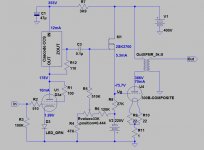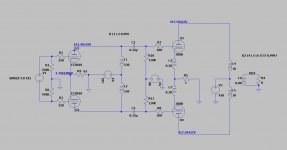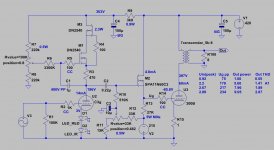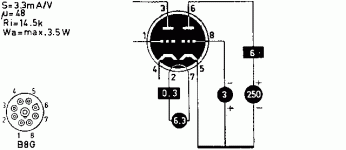I'll see if I did a reverse scheme. I also had his 6SN7 preamp and did a reverse scheme for it.
We are a very active audio community here in Southeast Michigan and many people heard this amp and loved it. The 26 worked really well driving the KR300B.
We are a very active audio community here in Southeast Michigan and many people heard this amp and loved it. The 26 worked really well driving the KR300B.
Last edited:
I'm trying yet again to find a single stage driver for a 300b. I've been through using DHTs like 26 and 10Y with a step-up on the input, in my case an op-amp. But I'd like an easier solution. Latest attempt is a 6N1P with both sections in parallel totalling 16mA and a Hammond 126B wired as a plate choke. It's not as disappointing as I imagined - decent but not a keeper. I like an EL33 in triode as a driver with other output tubes, but a mu of 20 isn't enough for a 300b. I'm assuming that a mu of 30 is a starting point. And triode operation not pentode.
Awaiting trial are E88CC, 6SL7 with both sections in parallel, and AC2. If I rig up a cathode/source follower I'll extend that to EF86 in triode and a few other pentodes in triode. I don't have any 6N7 and not so sure I want to buy any since the last time I used it I was quite disappointed.
Awaiting trial are E88CC, 6SL7 with both sections in parallel, and AC2. If I rig up a cathode/source follower I'll extend that to EF86 in triode and a few other pentodes in triode. I don't have any 6N7 and not so sure I want to buy any since the last time I used it I was quite disappointed.
What you'll end up (and all others, who try this attempt) is a whimsy sounding amp. It might function, generally and theorectical.
Last edited:
6J5?
I'm not considering anything with a mu less than 30. I already have EL33 with a mu of 20 which I like a lot.
As for a "whimsy" sounding amp, that's a possibility. I prefer using an output tube with more gain so I have a better choice of drivers, and I can use a driver like the EL33, KT61 etc. in triode. or even a 10Y. I blow hot and cold over a 300b as an output tube. Every now and then I come back to it, but I haven't found a solution I really like yet.
6J5?
My recommendation would be a D3A or E810F in triode connection.
Indeed - the data for the D3A suggests 24mA current which should be pretty good. The E810F can take 20mA current so good too. What holds me up about these choices is that I don't have a scope and with the high transconductance I'm likely to run into oscillation problems.
Scopes these days are not too expensive, probably worth investing in one.
A grid stopper resistor of 100 ohms or so and a ferrite bead are helpful. I place a 10R and ferrite bead on the plate lead.
Cathode with LED bias, short and direct to low impedance ground or grid bias with cathode direct to ground.
I would stay below 20mA in both cases, the higher the plate current, the higher the transconductance and the greater the possibility of oscillation. An FM portable radio can sometimes be helpful for sniffing out oscillation.
A grid stopper resistor of 100 ohms or so and a ferrite bead are helpful. I place a 10R and ferrite bead on the plate lead.
Cathode with LED bias, short and direct to low impedance ground or grid bias with cathode direct to ground.
I would stay below 20mA in both cases, the higher the plate current, the higher the transconductance and the greater the possibility of oscillation. An FM portable radio can sometimes be helpful for sniffing out oscillation.
I use this for -more than- a decade.
D3a or E280F as VAS.
I tried E810F too, but its H3 groving rapidly (more than previous ones) at large swing.
D3a or E280F as VAS.
I tried E810F too, but its H3 groving rapidly (more than previous ones) at large swing.
Attachments
Last edited:
I have great success with the EC8010. It is a great tube. u=60 and S=28mA/V.
There is plan for my next amp. 300B in PP.
There is plan for my next amp. 300B in PP.
Attachments
Last edited:
What you'll end up (and all others, who try this attempt) is a whimsy sounding amp.
Right, it has to be resistor loading, max 100KOhm.
I still have 24 NOS in original box Siemens C3g.
Very linear in triode; mu 40; Rp ~ 2k, and better grid voltage "room" than D3a, E810F.
What to do with these....??
Very linear in triode; mu 40; Rp ~ 2k, and better grid voltage "room" than D3a, E810F.
What to do with these....??
Sell them, and go for a 3 Michelin star meal. Seen the recent prices?
Back to the first question, I really like the 6e6p-dr
Back to the first question, I really like the 6e6p-dr
I still have 24 NOS in original box Siemens C3g.
Very linear in triode; mu 40; Rp ~ 2k, and better grid voltage "room" than D3a, E810F.
What to do with these....??
Some years ago I built a 300B for my friend with C3g.
Off
I also have some C3g, and built a phono (C3g, C3g, D3a as CF) with its.
On
Attachments
I had excellent results with the 7F8, paralleling the two sections.
How do you have enough gain with 7F8 (6SN7) into 300b? Do you have added gain in the preamp? Or very sensitive speakers?
I had excellent results with the 7F8, paralleling the two sections.
View attachment 9199507F8 has μ=48 each section , it is not 6SN7.
Sorry - must have got my wires crossed! Yes - it's a loctal predecessor to the 12AT7. Looks fairly common in the USA but rarer in the UK.
- Home
- Amplifiers
- Tubes / Valves
- 300b with single stage driver, C3M or?



